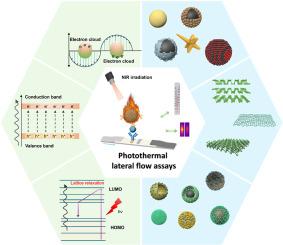Photothermal lateral flow assays for food contaminant detection: Principles, nanoprobes, and emerging detection strategies
IF 6.3
1区 农林科学
Q1 FOOD SCIENCE & TECHNOLOGY
引用次数: 0
Abstract
Lateral flow assays (LFAs) are adaptable and extensively utilized analytical instruments for detecting food risks, environmental pollutants, and disease-associated biomarkers. However, conventional colorimetric lateral flow assays are constrained by low sensitivity and specificity. Practical challenges such as the hook effect, narrow dynamic range, and subjective visual interpretation hinder the reliability of results. Additionally, matrix interferences from food components can obscure color development, complicating detection. This review elucidates the advances in photothermal LFAs for detecting food contaminants, emphasizing their ability to overcome the limitations of conventional colorimetric methods. The underlying principle and widely accepted light-to-heat conversion mechanisms are introduced, while the superior performance of photothermal LFAs in the sensitive detection of trace-level food hazards is highlighted. The crucial components of photothermal LFAs, including photothermal nanomaterials (Au nanocomposites and their derived nano-assemblies, polymer-decorated nanomaterials, flexible nanosheets) and photothermal readers (thermal imagers and smartphone-integrated portable readers), are summarized. Various analytical modalities of photothermal-derived platforms are shown, encompassing single-readout, colorimetric/photothermal dual-readout, and multiple-readout detection. The utilization of photothermal LFAs for identifying diverse pollutants in food matrices is clarified, highlighting its relevance in food safety. Despite their advantages, photothermal LFAs still require specialized instrumentation, which may increase costs and complexity. Signal readout challenges, such as calibration issues and temperature sensitivity, can also impact accuracy, particularly under varying environmental conditions. Nevertheless, continuous advancements in new photothermal nanomaterials and economical signal readers are anticipated to render photothermal LFAs commercially viable, facilitating their adoption as alternate ways for ensuring food safety.

食品污染物检测的光热横向流动分析:原理、纳米探针和新兴检测策略
横向流动分析(LFAs)是一种适应性强且广泛使用的分析工具,用于检测食品风险、环境污染物和疾病相关的生物标志物。然而,传统的比色横向流动分析受到低灵敏度和特异性的限制。诸如钩效应、窄动态范围和主观视觉解释等实际挑战阻碍了结果的可靠性。此外,来自食品成分的基质干扰会模糊颜色的发展,使检测复杂化。本文综述了光热LFAs检测食品污染物的进展,强调了它们克服传统比色法局限性的能力。介绍了光热LFAs的基本原理和广泛接受的光热转换机制,并强调了光热LFAs在灵敏检测痕量食品危害方面的优越性能。综述了光热LFAs的关键组成部分,包括光热纳米材料(金纳米复合材料及其衍生的纳米组件、聚合物修饰纳米材料、柔性纳米片)和光热读取器(热成像仪和集成智能手机的便携式读取器)。展示了光热衍生平台的各种分析模式,包括单读出、比色/光热双读出和多读出检测。阐明了光热LFAs在识别食品基质中各种污染物方面的应用,强调了其在食品安全方面的相关性。尽管有这些优点,光热LFAs仍然需要专门的仪器,这可能会增加成本和复杂性。信号读出方面的挑战,如校准问题和温度灵敏度,也会影响精度,特别是在不同的环境条件下。然而,新型光热纳米材料和经济信号读取器的不断进步有望使光热lfa在商业上可行,促进其作为确保食品安全的替代方法的采用。
本文章由计算机程序翻译,如有差异,请以英文原文为准。
求助全文
约1分钟内获得全文
求助全文
来源期刊

Food Control
工程技术-食品科技
CiteScore
12.20
自引率
6.70%
发文量
758
审稿时长
33 days
期刊介绍:
Food Control is an international journal that provides essential information for those involved in food safety and process control.
Food Control covers the below areas that relate to food process control or to food safety of human foods:
• Microbial food safety and antimicrobial systems
• Mycotoxins
• Hazard analysis, HACCP and food safety objectives
• Risk assessment, including microbial and chemical hazards
• Quality assurance
• Good manufacturing practices
• Food process systems design and control
• Food Packaging technology and materials in contact with foods
• Rapid methods of analysis and detection, including sensor technology
• Codes of practice, legislation and international harmonization
• Consumer issues
• Education, training and research needs.
The scope of Food Control is comprehensive and includes original research papers, authoritative reviews, short communications, comment articles that report on new developments in food control, and position papers.
 求助内容:
求助内容: 应助结果提醒方式:
应助结果提醒方式:


